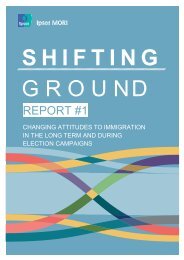You also want an ePaper? Increase the reach of your titles
YUMPU automatically turns print PDFs into web optimized ePapers that Google loves.
Ties <strong>that</strong> Bind<br />
27 Omissi, The Sepoy and the Raj,<br />
p.12<br />
28 Yuvraj Prasad, The Indian<br />
Muslims and World War I: A<br />
Phase of Disillusionment with<br />
British Rule, 1914-1918 (Delhi,<br />
1985) p.43<br />
29 Omissi, The Sepoy and the Raj<br />
p.39<br />
14 | policyexchange.org.uk<br />
Table 1: Regional origin of Indian Army recruitment expressed<br />
as percentage of total, 1862-1914<br />
Region 1862 1885 1892 1914<br />
Hindustan east of the Yamuna (including the UP and Bihar) 21.4 16.4 13.0 12.4<br />
Bombay (including Rajputna and Central Indian provinces) 22.9 21.3 22.6 14.8<br />
Madras 30.5 26.2 21.7 9.0<br />
Nepal, Punjab and NWFP 25.2 36.1 43.0 63.6<br />
The received wisdom after the Mutiny was <strong>that</strong> regional recruitment should<br />
be ‘balanced’, thus limiting the risk of rebellion if one province was subverted;<br />
and <strong>that</strong> the size of India’s army should be reduced. The Army’s shift in<br />
emphasis towards predominantly north-western regions was principally<br />
motivated by the fear <strong>that</strong> India would soon have to defend itself against a<br />
Russian invasion. In the late nineteenth century, Russian power continued to<br />
seep southwards, most notably with the capture of Samarkand. Fear of <strong>that</strong><br />
confrontation prompted Lord Roberts (then a Lieutenant-General) to emphasise<br />
recruitment from the Punjab and NWFP, whose men he regarded as being<br />
among the most ‘warrior like’ in India. It was an idea <strong>that</strong> ultimately gave rise<br />
to the ‘martial races’ theory which suggested <strong>that</strong> certain groupings, due to<br />
their ethnic and genetic composition, made better soldiers. London embraced<br />
the idea, with the Eden Commission Report on the Indian Army reporting to<br />
Parliament <strong>that</strong> ‘the Punjab is the home of the most martial races of India and<br />
is the nursery of our best soldiers’. 27 It ensured <strong>that</strong> the new Indian Army<br />
recruited particularly heavily from the northern and north-westerly regions of<br />
the country. Those areas <strong>that</strong> did attract the attention of military recruiters often<br />
became intensely loyal and receptive to British rule – reaping the benefits <strong>that</strong><br />
service to the Raj often brought.<br />
By 1914, the Muslim population of British India was 57 million, of which<br />
eighty percent was concentrated in the northern regions from the Bengal in the<br />
east to the Punjab and NWFP in the west. 28 The table below gives an indication of<br />
just how heavily recruitment was focused on these regions during the early stages<br />
of the war. 29<br />
Table 2: Regional recruitment to the Indian Army of active<br />
combatants, 1914 – 1916<br />
Region 1914 1915 1916 Total<br />
Punjab 14000 46000 50000 <strong>11</strong>0000<br />
NWFP 3000 6000 5000 14000<br />
Nepal 3000 14000 15000 33000<br />
Rest of India 8000 28000 32000 68000<br />
Total 28000 93000 104000 225000<br />
Year<br />
Year



